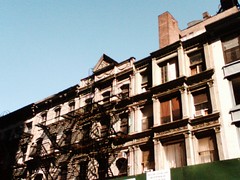North:
Corner (816 6th Ave): Bill's Flower Market
57: This building was once a high-class
gambling den run by William "Dink" Davis.

55: In 1911, Emma Goldman made this the
address of her anarchist magazine Mother Earth
49-51: Paul Meconi Inc., Wholesale Florists was M. Witmark & Songs
(''Sweet Adeline," ''Hello Central, Give Me
Heaven'') from 1893-98. No. 51 was later Paul Dresser Publishing Co. (1905-06).
47: Another Paul Meconi storefront was the office of the New York Clipper, ''the oldest American Sporting
& Theatrical Journal'';
top floor was Whitney-Warner Publishing Company (''Hiawatha'').
45: Shapiro, Bernstein & Company, music publisher (1899-1904); opulent office boasted a ''Turkish Corner'' with
colored lights. Later the Jerome
Remick Music Co., where a teenaged
George Gershwin worked as a song plugger (1914-17). Among his customers were Fred and
Adele Astaire, a vaudeville song-and-dance team. Gershwin met
Irving Caesar here, with whom he wrote "Swanee."
43: Great Magic Int'l and Rainbow Asia Imports are in the former offices of agent
William Morris (1903); Morris
at the time booked acts for the vaudeville
circuit, the U.S.'s first national entertainment system. This was also the office of Helf & Hager's Hitland (''Everybody
Works but Father''). In 1892 this was the address of the American Actors' Amateur Athletic Association.
41: Aida's & Jimi's Merchandising Co. was P.J. Howley Music Company (1905-07).
37-39: A 12-story building designed by George F. Pelham
and completed in 191l. Imperial Umbrellas was Gotham Music Co.;
Harry von Tilzer was also found at No. 37.
Earlier this was the address of the Alhambra, a
Tenderloin-era dance hall.
|